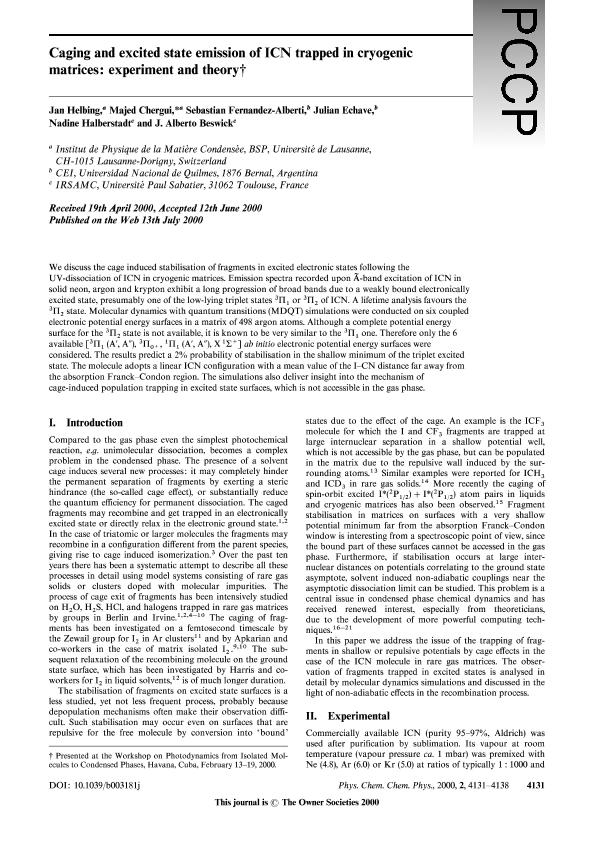Artículo
Caging and excited state emission of ICN trapped in cryogenic matrices: Experiment and theory
Helbing, J.; Chergui, M.; Fernández Alberti, Sebastián ; Echave, Julián
; Echave, Julián ; Halberstadt, N.; Beswick, J. A.
; Halberstadt, N.; Beswick, J. A.
 ; Echave, Julián
; Echave, Julián ; Halberstadt, N.; Beswick, J. A.
; Halberstadt, N.; Beswick, J. A.
Fecha de publicación:
09/2000
Editorial:
Royal Society of Chemistry
Revista:
Physical Chemistry Chemical Physics
ISSN:
1463-9076
Idioma:
Inglés
Tipo de recurso:
Artículo publicado
Clasificación temática:
Resumen
We discuss the cage induced stabilisation of fragments in excited electronic states following the UV-dissociation of ICN in cryogenic matrices. Emission spectra recorded upon A-band excitation of ICN in solid neon, argon and krypton exhibit a long progression of broad bands due to a weakly bound electronically excited state, presumably one of the low-lying triplet states 3Π1 or 3Π2 of ICN. A lifetime analysis favours the 3Π2 state. Molecular dynamics with quantum transitions (MDQT) simulations were conducted on six coupled electronic potential energy surfaces in a matrix of 498 argon atoms. Although a complete potential energy surface for the 3Π2 state is not available, it is known to be very similar to the 3Π1 one. Therefore only the 6 available [3Π1 (A', A''), 3Π(o)+, 1Π1 (A', A''), X 1Σ+] ab initio electronic potential energy surfaces were considered. The results predict a 2% probability of stabilisation in the shallow minimum of the triplet excited state. The molecule adopts a linear ICN configuration with a mean value of the I-CN distance far away from the absorption Franck-Condon region. The simulations also deliver insight into the mechanism of cage-induced population trapping in excited state surfaces, which is not accessible in the gas phase.
Palabras clave:
Photodynamics
,
Caging
,
Condensed Phase
Archivos asociados
Licencia
Identificadores
Colecciones
Articulos(SEDE CENTRAL)
Articulos de SEDE CENTRAL
Articulos de SEDE CENTRAL
Citación
Helbing, J.; Chergui, M.; Fernández Alberti, Sebastián; Echave, Julián; Halberstadt, N.; et al.; Caging and excited state emission of ICN trapped in cryogenic matrices: Experiment and theory; Royal Society of Chemistry; Physical Chemistry Chemical Physics; 2; 18; 9-2000; 4131-4138
Compartir
Altmétricas



